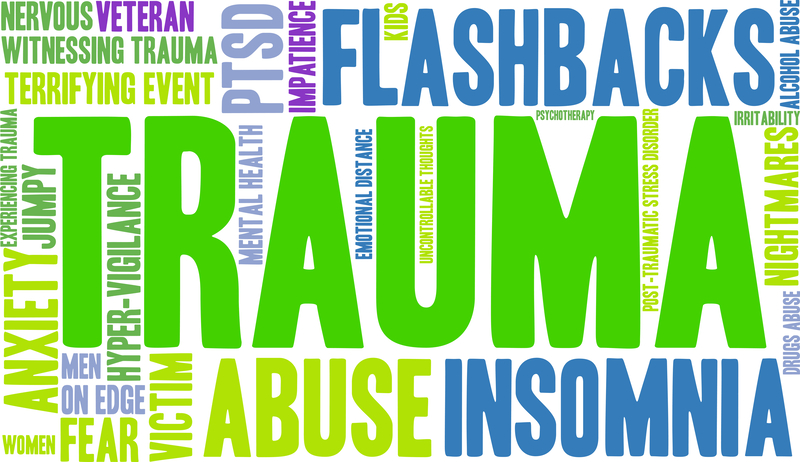Trauma has become a household word and a social media trend. We use it to describe many events, both in our personal lives and our collective experiences, and there seems to be more societal dialogue around the concept of trauma than ever before. TikTok has many trending hashtags around trauma such as #trauma, #traumarecovery, #traumabonding, #traumatherapy, #healingtrauma and so many more. There is now more access to information on trauma than ever before and even more people publicly sharing their experiences with trauma through their social media platforms.

There are many benefits to opening up dialogue around mental health, especially around trauma. Trauma is pervasive in our society and in our world and affects many of us. In the mental health sphere, trauma is common and informs much of the work that we do in therapy. Research shows that nearly 80% of individuals treated for mental health disorders have experienced at least one traumatic event in their lifetime. Now with our world experiencing a global pandemic and all of its fallout, it is rare to find someone who hasn’t been touched by the effects of trauma in some way, shape, or form. So what are the consequences, both positive and negative, of trauma becoming a part of our normal language and our social media content? I’m glad you asked. reactions [that are] characterized by a sense of horror, helplessness, serious injury, or the threat of serious injury or death.” Trauma can lead to many mental health issues and is represented by a whole section of disorders in the Diagnostic and Statistical Manual of Mental Disorders, with post-traumatic stress disorder being the most well-known.
What is Trauma?
Let’s start with a working definition for trauma. The Center for Disease Control defines a traumatic event as “an event, or series of events, that causes moderate to severe stress
I’ve found the distinction between “Large T” traumas and “Little T” traumas to be helpful in understanding and differentiating between traumatic events and experiences. Large T traumas refer to significant and life threatening events such as experiencing/witnessing violence, witnessing death, car accidents, terrorist attacks, experiencing war or a natural disaster, etc. Little t traumas refer to distressing events that overwhelm our coping abilities or disrupt our emotional functioning. While these events are not usually life threatening, they are often a series of ongoing, emotionally distressing situations that cause distress. Examples of little t traumas include bullying, divorce, harassment, financial stressors, interpersonal conflict, infidelity, etc. Just about everyone tends to experience things that overwhelm us, but it is the ongoing nature and the way it impacts our ability to function that categorizes it as an actual trauma.
Benefits of a Society Talking About Trauma
When we live in a society that is aware of what trauma is and the impacts it can have, there can be many benefits on the individual and societal level. A society talking about trauma tends to be more accepting around treatment. We can see a shift in generational acceptance around mental health treatment in our own country. Members of Gen Z are engaging in higher levels of treatment than any other generation and each generation has less representation among those receiving services. Greater acceptance can lead to more access to resources for mental health and increased social support when we or our loved ones engage in therapy or other forms of treatment. This normalizing effect can lead to people being willing to share or talk about their own traumas in a therapeutic or beneficial way.
When we are talking about trauma more openly, we tend to have the opportunity to be better educated about it. Understanding the effects of trauma can help us to extend empathy towards unwanted behaviors or thoughts resulting from trauma, either to others or to ourselves. There is so much information readily accessible about trauma for people at all ages, through books, internet resources and even social media accounts. A society talking about trauma will likely invest in research about trauma and its effects, leading to a deeper understanding as well as better treatment.
Talking about trauma can lead to social change. When we consider the #MeToo movement or the allegations made by the female gymnasts against Larry Nassar, people came forward and shared stories of their own traumas in order to bring awareness to unacceptable forms of abuse that were often silenced or taboo. The more people that vulnerably shared their stories, the more evidence and accountability there was against perpetrators. This public sharing of trauma has allowed others to feel less alone in their own experiences of abuse, has shifted some policies, and even our social narrative around what is acceptable behavior.
Dangers of Using Trauma Too Casually
While there are many benefits to trauma becoming a part of our collective language, there are certainly dangers to consider as well. Today, trauma can be used colloquially for any level of negative emotional experience. The danger of this is that it minimizes the significance of those who have truly suffered traumas. If we start to label any level of discomfort or unpleasant interaction as a trauma, we take away the mental health impacts and need for treatment. We minimize the pain, long lasting impact of trauma and we invalidate true trauma experiences.
Trauma has become a social media trend and TikTok is constantly talking about trauma. When sharing traumas on social media, our personal hurts and wounds are widely available for public consumption and we have limited control over who comments, replies, or shares our stories. While there is certainly a time and a place where sharing stories online can be helpful or healing, it is dangerous to do so without having processed the trauma in a safe environment with trusted people. When trauma sharing becomes a viral trend, we can jump in and feel a part of something bigger than ourselves at first but may not consider the consequences or backlash of sharing something so personal in such a public way.
There have also been trends and hashtags around labeling common trauma responses, where many videos are posted claiming that just about any behavior is probably a trauma response. When this type of language is used casually or broadly, it can even become used as an excuse for behaviors that are socially unacceptable or morally wrong. When trauma becomes a trendy topic on social media, it can lead to pseudo mental health care where individuals are learning about and trying to treat their own trauma through influencers and mental health accounts instead of seeking licensed, clinical support. We can believe or trust any information we see without knowing the credentials or reliability of the person sharing it.
So Where Do We Go From Here?
As a therapist, I am certainly an advocate for continued education on and conversation about trauma and its effects in our society and our world. I’m proud to see a growing acceptance of and desire for mental health treatment in younger generations and believe that with knowledge and support there is hope that generational trauma can be healed from and even stopped from being passed along. At the same time, I think it’s important to hold the definition of and the use of the word trauma with a high level of respect as a way of honoring and respecting those who have been victims of trauma. As consumers of news, media, and information let’s be diligent about seeking to figure out what is true and not minimizing the significance of trauma by over- or misusing it. And if you are someone who has experienced trauma and are considering if therapy might be the right next step for you, we’d encourage you to reach out to us at Milestones and consider how we might walk alongside you towards healing.

